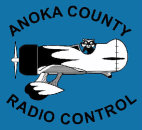All flyers should keep pilots informed of the runway condition so that they donít have to take their eyes
off of their aircraft. Call out your takeoffs, touch and goes, and landings so that other pilots are aware of your intentions.
If you are standing on or near the runway when you take off it is especially important that you let the other pilots know that you
are there. Clear the runway area and go to your pilot station as soon as you take off.
REMEMBER - Dead stick landings have priority over all other landings and takeoffs. If you are on final approach and someone calls out for a
dead stick landing, call a go around and get out of the way.
The airspace over the runway is normally restricted to Take-offs, Landings, Touch and Goes, and landing pattern practice; with high-speed passes,
aerobatics and hovering* done east of the runway. High-speed passes, aerobatics and hovering* can be done over the runway in certain instances such as:
- Only 1 aircraft is in the air.
- At Fun Flies.
- For flight demonstrations at ACRC events.
- With prior agreement of all the on the pilots on the flight line.
- For any other instances pre-approved by the ACRC Board.
(*Note:Helicopter hovering practice is to be done in the southwest corner of the parking lot.)
Pilots should use the pilot stations at the downwind end of the runway. This is for the pilotís safety,
in case something happens to the plane on takeoff or rollout after landing.
Example - if the wind is from the north, the stations at the south end of the field should be used.
There should be no taxiing west (past) the pilot stations. In the area west of the pilot stations aircraft should be carried or be under some sort of physical control.
- The flying field is not the place to break in a new engine. If you have an engine that needs major adjusting, wait for your frequency to become available and move to
the end of the pit area to do the adjustments. Long term running of engines in the pit area can be detrimental to hearing. The 15-minute time limit for using a frequency
applies whether you are flying or adjusting an engine.
When starting an engine, make sure that no one is in line with the propeller and the prop blast is not blowing on someoneís equipment. Thrown propeller blades can
go both sideways and forward. It is recommended that safety glasses of some sort are worn and some sort of hearing protection is used. All guests and helpers should be in a
safe position
Noise is the number one complaint about R/C aircraft and the main reason that flying sites are being lost. It is imperative that you be sensitive to the effects of excess
noise. Design and fly your models with the flying site neighbors in mind. Put yourself in their place. How would you feel and react?
Fly in a manner that will be interpreted as being responsible by all observers. Flying fast or low near the pits or near any vehicle or building may not only violate
club rules, but may turn people against our club and/or club members.






